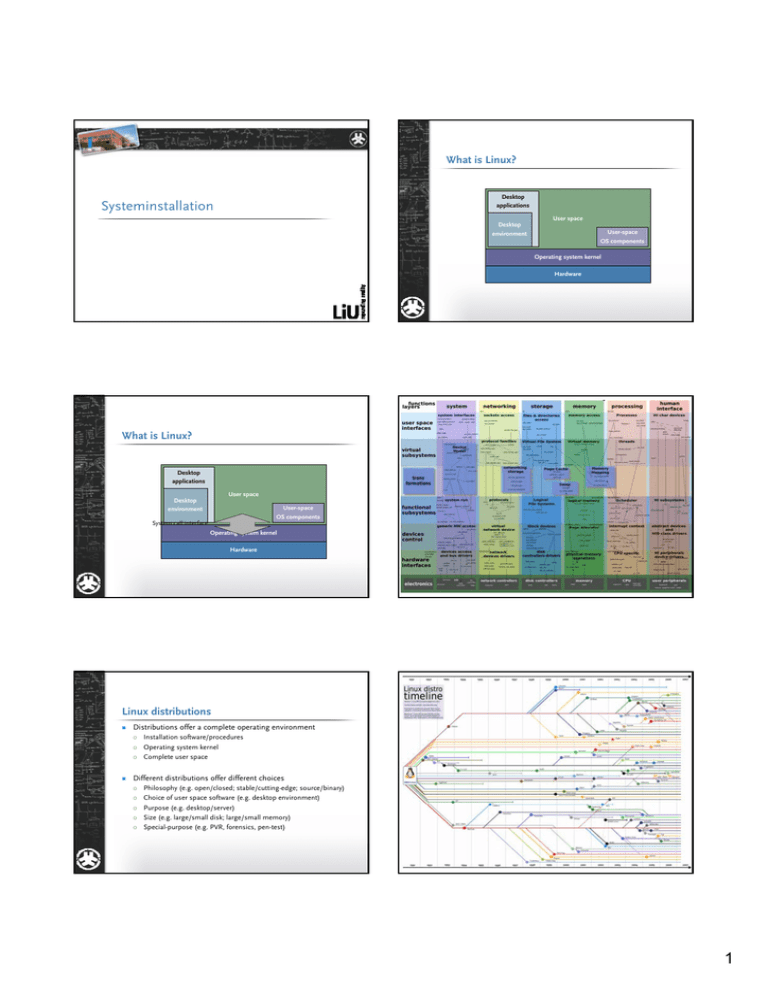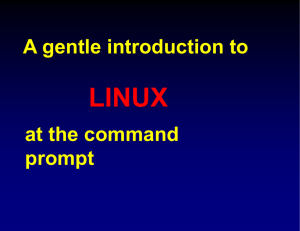Systeminstallation What is Linux?
advertisement

What is Linux? Desktop applications Systeminstallation User space Desktop environment User-space OS components Operating system kernel Hardware What is Linux? Desktop applications User space Desktop environment User-space OS components System call interface Operating system kernel Hardware Linux distributions Distributions offer a complete operating environment o Installation software/procedures o Operating system kernel o Complete user space Different distributions offer different choices o o o o o Philosophy (e.g. open/closed; stable/cutting-edge; source/binary) Choice of user space software (e.g. desktop environment) Purpose (e.g. desktop/server) Size (e.g. large/small disk; large/small memory) Special-purpose (e.g. PVR, forensics, pen-test) 1 What about Unix? A look at Linux: files and file systems What is Unix? o Unix was an operating system developed by Bell Labs, then AT&T, then many, many others o Unix is a trademark held by the Open Group o Unix is an idea Standard Unix: SUS and POSIX Applications go through VFS VFS passes all requests to appropriate logical file system Logical file system gets data from wherever it wants to Application System call interface Virtual File System Interface Logical file systems Unified interface to all files Anything can be a file ext2 o Same (or similar) user space o Based on similar ideas SCSI Disk Network subsystem IDE Disk USB Disk Single directory hierarchy o No ”drive letters” o Starts at / We mean the specification of the data structures that the software uses to store files and data ”Mounting” o Attaches a file system (e.g. ext2 file system on a hard drive, or file system exported using NFS) to a point in the file system hierarchy o The ”root file system” is the file system mounted at /, and must be mounted during system startup o It is possible to mount the same file system several times in different locations o It is possible to specify options (e.g. read only) when mounting o Default mounts in /etc/fstab (on Linux) o ”The ext2 superblock is replicated for reliability purposes.” proc File system organization We mean the software that VFS uses to get files and data o ”Have you loaded ufs into the kernel?” nfs Block device What do we mean when we say ”file system”? vfat Linux feels like Unix We mean the actual data structures stored on a disk (and the simulated ones provided by non-storage file systems) o ”I need to verify the integrity of the file system on /dev/hda1.” Example of mounting file systems Standard hierarchy mount –t ext2 –o noexec /dev/hda2 /data mount –t nfs –o rw atlas:/users/9/3/alean938 /home/alean938 / File system type: ext2 Options: noexec Source: /dev/hda2 (blockenhet) Mount point: /data File system type: nfs Options: rw Source: atlas:/users/9/3/alean938 Mount point: /home/alean938 / home / atlas:/ users data 0 alean938 … 2 /dev/hda1 home 1 … 9 bin boot dev etc X11R6 bin include lib home local lib sbin media mnt sbin srv tmp usr var share doc cache lib lock log run spool tmp data alean938 3 4 … /dev/hda1 alean938 2 Overview of the ext2 filesystem (on disk) The inode Boot block Block group 0 Block group 1 Block group 2 Ext2 file system Every filesystem object is represented by an inode o Superblock Group descriptor Block bitmap Inode bitmap Inode table Data blocks Block group o Magic number … Mode Data First inode Owner Data superblock Size Data Timestamp Direct blocks Data o o o o The VFS does not care about different kinds of objects Higher layers may treat different objects differently Regular files Directories Device nodes Sockets Pipes The inode does not contain the name or location of an object Names are linked to inodes through directory entries o o Data directory i1 14 5 file i2 14 9 Indirect blocks Data Double indirect Data Creation and modification time Mode (permissions) Owner and group Behavior (read, write, etc.) Some kinds of objects o o o o o Data Some contents of an inode Every inode can have multiple names (known as links) An inode does not need any names at all Triple indirect filename inode An inode example: multiple links You can see inodes using the ls command in Linux o o Use ls –i to see inode numbers Use ls –l to see more data Same inode but different names % cd /bin % ls -i bz* 349924 bzcat 349923 bzegrep 349923 bzgrep 349930 bzless 349925 bzcmp 349928 bzexe 349924 bzip2 349930 bzmore 349925 bzdiff 349923 bzfgrep 349931 bzip2recover % ls -li bzegrep bzfgrep bzgrep 349923 -rwxr-xr-x 3 root root 3642 Aug 25 2006 bzegrep 349923 -rwxr-xr-x 3 root root 3642 Aug 25 2006 bzfgrep 349923 -rwxr-xr-x 3 root root 3642 Aug 25 2006 bzgrep % Mode Another example of multiple links Directories have multiple links o o o One for the name One for ”.” One for each ”..” in each subdirectory Just different names for the same inode % ls -di1 /usr /usr/. /usr/bin/.. /usr/local/.. 206753 /usr 206753 /usr/. 206753 /usr/bin/.. 206753 /usr/local/.. % ls -ldi /usr 206753 drwxr-xr-x 13 root root 4096 Apr 20 12:06 /usr % Owner and group One for /usr One for /usr/. Eleven for subdirectories Number of links Another inode example: special files Permissions Non-file and directory objects o o o o Block devices (”block special”; e.g. hard disks) Character devices (”character special”; e.g. sound cards) Unix domain sockets Pipes (FIFOs) % ls -l /tmp/.X11-unix/X0 srwxrwxrwx 1 root root 0 Aug 13 13:28 /tmp/.X11-unix/X0 % ls -l /dev/hda1 brw-rw---- 1 root disk 3, 1 Aug 13 13:27 /dev/hda1 % mkfifo /tmp/fifo % ls -l /tmp/fifo prw-r--r-- 1 root root 0 Aug 17 11:01 /tmp/fifo % ls -l /dev/audio crw-rw---- 1 root audio 14, 4 Aug 13 13:27 /dev/audio % Socket Block special Pipe (FIFO) Character special % ls -l example -rwxrwxrwx 1 root root 0 Aug 17 12:27 example % Read Write Execute User 4 2 1 Group 4 4 2 2 1 1 Other Numerical permissions User: Read + Write + Execute = 4+2+1 =7 Group: Read + Execute = 4+2 =6 Other: Execute = 1 =1 Mode: 761 3 How do ”user” and ”group” work? Where are users and groups defined Conceptually: if the user who owns the file attempts to access it, use ”user” permissions; if a user who belongs to the same group as the file attempts to access it, use ”group” permissions But how does the operating system know? All accesses are performed by processes and… …every process has an ”effective user ID” (EUID) and an ”effective group ID” (EGID) …every user belongs to a set of groups How are users defined? Depends on what /etc/nsswitch.conf says o The ”name service switch” allows users and groups (and other data) to be retrieved from many different sources o The default is ”local files” (/etc/passwd and /etc/group) % cat /etc/nsswitch.conf # /etc/nsswitch.conf passwd: files nis group: files nis shadow: files Users are stored in local files and in NIS Groups are stored in local files and in NIS How are groups defined? % head -4 /etc/passwd root:x:0:0:root:/root:/bin/bash daemon:x:1:1:daemon:/usr/sbin:/bin/sh bin:x:2:2:bin:/bin:/bin/sh sys:x:3:3:sys:/dev:/bin/sh % tail -4 /etc/group ntp:x:111: smmta:x:112: smmsp:x:113: uml-net:x:114: % ypcat passwd | head -4 lindu932:*:24083:6000:Linus Dunkers:/home/lindu932:/bin/tcsh frehi371:*:20883:6000:Fredrik Hillerborg:/home/frehi371:/etc/notsignedsh thogu383:*:17926:6000:Thomas Gustafsson:/home/thogu383:/etc/closedsh tanmi350:*:55718:6000:Tanja Mitic:/home/tanmi350:/bin/tcsh % ypcat group | head -4 TDDB34:*:9197:eribe,evalu,johfa,jonlu,mikki TDDB30:*:9194:diasz,snt,ulfni TDDA13:*:9161:bouka,patdo HKGD20:*:9436:bjojo,eriho,jonlu,matar,yuhhu User Name Password Full name User ID Primary group Shell Home directory Processes All execution takes place in processes o o o o Each process may consist of several threads Every process has its own (protected) address space Every process has an ID, a parent, and a controlling tty Processes have a state (running, stopped, suspended, etc) Processes can communicate o o o o Signals are simple asynchronous messages Processes can share memory areas Processes can communicate using pipes Processes can communicate using sockets Group Name Group ID Password Members Example of processes % S S S S S S S R S S S S S ps -H -eo s,pid,ppid,tty,user,cmd PID PPID TT USER CMD 1 0 ? root init [2] 2188 1 ? snmp /usr/sbin/snmpd -Lsd -Lf /dev/null -u snmp 2194 1 ? root /usr/sbin/sshd 24294 2194 ? root sshd: davby [priv] 24296 24294 ? davby sshd: davby@pts/0 24297 24296 pts/0 davby -sh 24304 24297 pts/0 davby ps -H -eo s,pid,ppid,tty,user,cmd 2206 1 ? uml-net /usr/bin/uml_switch -tap tap0 -unix 2273 1 ? statd /sbin/rpc.statd 2297 1 ? root sendmail: MTA: accepting connections 2323 1 ? ntp /usr/sbin/ntpd -p /var/run/ntpd.pid 2333 1 ? daemon /usr/sbin/atd EUID Process ID Controlling terminal Command Parent process ID 4 Signals % ps axu | grep ’[e]macs’ davby 24613 0.6 0.2 % kill –HUP 24613 % ps axu | grep ’[e]macs’ % Privilege elevation User point-of-view: suspend, resume, kill processes 9604 4596 pts/1 S+ 15:47 Users gain extra privileges by changing EUID or starting processes with a different EUID than the current one 0:00 emacs -nw Send arbitrary signals using kill command If typing directly to process’s controlling tty o C-c sends INTR o C-z sends TSTP o C-\ sends QUIT % S S S S S S R S S S S ps -H -eo s,pid,ppid,tty,user,cmd PID PPID TT USER CMD 1 0 ? root init [2] 2194 1 ? root /usr/sbin/sshd 24294 2194 ? root sshd: davby [priv] 24296 24294 ? davby sshd: davby@pts/0 24297 24296 pts/0 davby -sh 24321 24297 pts/0 davby ps -H -eo s,pid,ppid,tty,user,cmd 24312 2194 ? root sshd: davby [priv] 24314 24312 ? davby sshd: davby@pts/1 24315 24314 pts/1 davby -sh 24319 24315 pts/1 root passwd sshd changed EUID from root to davby passwd being run by davby with EUID root How does privilege elevation work? o The seteuid system call changes the EUID o The setegid system call changes the EGID o Very strict limitations on who can change to what Example of setuid/setgid programs Programs can change their own EUID/EGID % ls -l passwd crontab -rwxr-sr-x 1 root news -rwsr-xr-x 1 root root -rwsr-sr-x 1 root mail % mail 26380 Dec 20 2006 crontab 28480 Feb 27 08:53 passwd 72544 Apr 30 2006 procmail Programs can have the setuid/setgid bits set o When setuid program started, process assumes file owner as EUID o When setgid program started, process assumes file group as EGID crontab is setgid news passwd is setuid root procmail is setuid root and setgid mail The shell When a user logs in, the login program starts a shell The shell accepts and interprets commands from the user o Handles I/O redirection, environment variables, etc Two kinds of commands: built-in and external o Built-in: affect the shell itself (e.g. cd) or are run often (e.g. echo) o External: most everything else o Also: programming structures (e.g. if-then-else) External commands are just files with the execute permission set that are in a directory listed in the PATH variable System startup What happens when you start Linux 1. 2. 3. 4. The computer firmware (BIOS) loads the boot loader The boot loader loads and executes the operating system The operating system runs the /sbin/init program The /sbin/init program does what /etc/inittab says to do Set default run level to 2 % cat /etc/inittab id:2:initdefault: To do when si::sysinit:/etc/init.d/rcS initializing system l1:1:wait:/etc/init.d/rc 1 To do (once) when l2:2:wait:/etc/init.d/rc 2 entering run level 2 l3:3:wait:/etc/init.d/rc 3 1:23:respawn:/sbin/getty 38400 tty1 To do when entering 2:23:respawn:/sbin/getty 38400 tty2 run level 2 or 3 (and 3:23:respawn:/sbin/getty 38400 tty3 when process terminates % it is restarted 5 Typical (sysvinit) system startup System logging /etc/init.d/rc script is run with run level as argument o Runs scripts in /etc/rcN.d directory o Scripts that start with K are run with argument stop o Scripts that start with S are run with argument start o Detailed messages often show up in system and application logs o By default, log files are stored in /var/log Note that /etc/rcS.d scripts are also run during boot % ls /etc/rc2.d S10sysklogd S11klogd S18portmap S19autofs % S20cupsys S20dbus S20devtun-rights S20dirmngr S20snmpd S20ssh S20sysfsutils S20sysinfo S21exim S23ntp S89atd S89cron Run with argument start to start ssh service System logging % ls -F /var/log account/ cfengine.log.0 acpid cfengine.log.1.gz acpid.1.gz daemon.log apache/ daemon.log.0 apache2/ daemon.log.1.gz aptitude debug aptitude.1.gz debug.0 auth.log debug.1.gz auth.log.0 dmesg auth.log.1.gz dpkg.log boot dpkg.log.1 btmp fai/ btmp.1 faillog cfengine.log fontconfig.log % fsck kern.log kern.log.0 kern.log.1.gz ksymoops/ lastlog lpr.log mail.err mail.err.0 mail.err.1.gz mail.info mail.info.0 mail.info.1.gz mail.log mail.log.0 mail.log.1.gz mail.warn mail.warn.0 mail.warn.1.gz messages messages.0 messages.1.gz mysql/ nagios/ nessus/ news/ ntpstats/ pycentral.log quagga/ samba/ syslog syslog.0 syslog.1.gz user.log user.log.0 user.log.1.gz uucp.log vtund/ wtmp wtmp.1 wtmp.report System logging Controlled by system logging service (syslogd) o Configured in /etc/syslog.conf o Controls what information goes where o Controls what level of information is logged % head -2 /var/log/syslog.conf auth,authpriv.* *.*;auth,authpriv.none Linux (and unix) systems and software are often very chatty /var/log/auth.log -/var/log/syslog Log everything except auth messages to /var/log/syslog % /etc/init.d/bind9 reload % tail -12 /var/log/syslog Aug 20 08:29:22 sysinst-gw postfix/cleanup[26219]: 3FE26748B9: messageid=<20070820062922.3FE26748B9@sysinst-gw.sysinst.ida.liu.se> Aug 20 08:29:22 sysinst-gw postfix/bounce[26258]: F24931F4B7: sender nondelivery notification: 3FE26748B9 Aug 20 08:29:22 sysinst-gw postfix/local[26259]: 3FE26748B9: to=<nagios@sysinstgw.sysinst.ida.liu.se>, relay=local, delay=0.16, delays=0.05/0.04/0/0.07, dsn=2.0.0, status=sent (delivered to mailbox) Aug 20 09:00:54 sysinst-gw named[7673]: loading configuration from '/etc/bind/named.conf' Aug 20 09:00:54 sysinst-gw named[7673]: zone 189.236.130.in-addr.arpa/IN: loaded serial 2007081500 Aug 20 09:00:54 sysinst-gw named[7673]: zone 189.236.130.in-addr.arpa/IN: sending notifies (serial 2007081500) Aug 20 09:00:54 sysinst-gw named[7673]: zone sysinst.ida.liu.se/IN: loaded serial 2007081500 Aug 20 09:00:54 sysinst-gw named[7673]: zone sysinst.ida.liu.se/IN: sending notifies (serial 2007081500) Aug 20 09:00:54 sysinst-gw named[7673]: client 130.236.177.25#34505: transfer of '189.236.130.in-addr.arpa/IN': AXFR-style IXFR started Aug 20 09:00:54 sysinst-gw named[7673]: client 130.236.177.25#34505: transfer of '189.236.130.in-addr.arpa/IN': AXFR-style IXFR ended Where to next? Any basic textbook on Linux will teach you more The UML lab will familiarize you with the virtual environment you will be using (and in the virtual environment you root access, so you can do anything you want) The LXB lab will go through a large number of basic Linux issues you need when installing and managing systems 6





